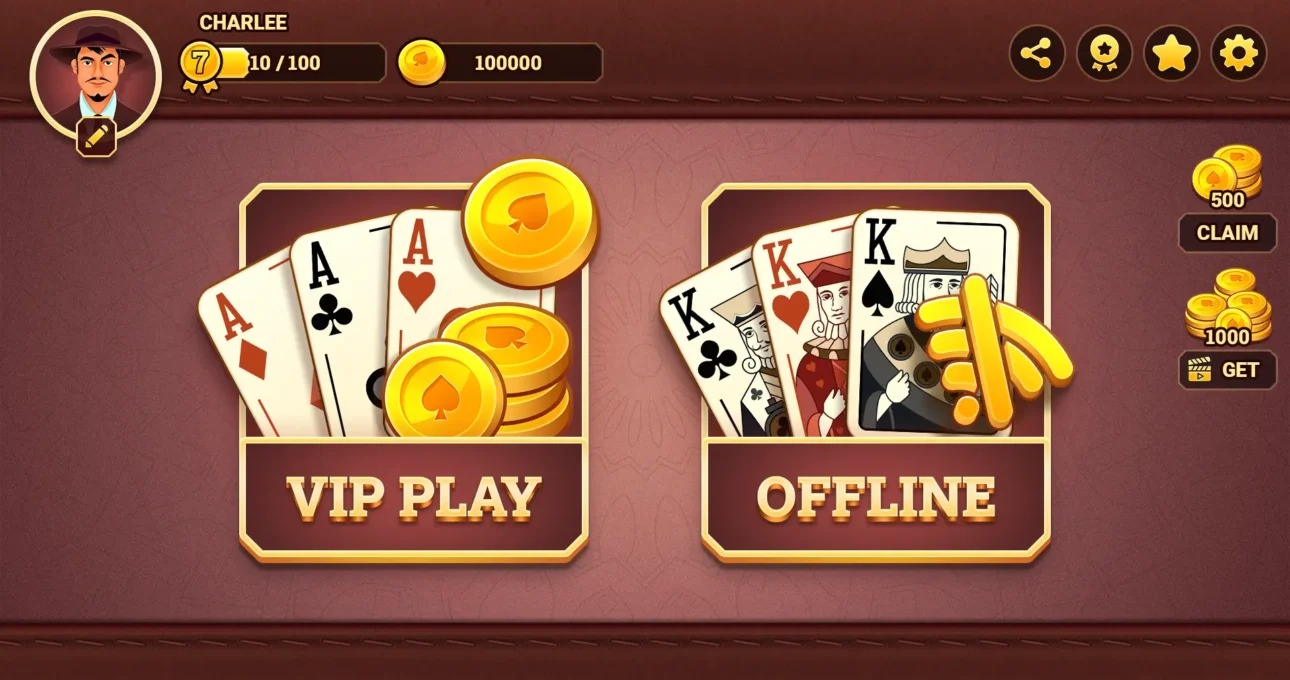About this game
This game, played in Bangladesh and Bhutan, is related to the British game 13-card Brag or Crash. Players divide their hands of 13 cards into sets of 3, 3, 3 and 4 which are compared in a similar way to hands at Brag or Teen Patti. However, unlike these other games, Hazari is played for points, each card having a point value. The winner of each comparison collects the played cards, and scores their point value. Hazari means 1000 and the aim of the game is to accumulate a score of 1000 points or more.



Players and Cards
Hazari is a game for four players using a standard international 52-card pack.
The rank of cards in each suit, from highest to lowest, is A, K, Q, J, 10, 9, 8, 7, 6, 5, 4, 3, 2.
The Aces, Kings, Queens, Jacks and Tens are worth 10 points each, and the numeral cards from 2 to 9 are worth 5 points each. The total value of the cards in the pack is 360.
Deal and play are counter-clockwise.
Card Combinations
The game of Hazari is based on comparing 3-card combinations. The types of combination from highest to lowest are: 1. Troy, 2. Colour Run, 3. Run, 4. Colour, 5. Pair and 6. Indi. A higher type of combination always beats a lower type – for example any Colour Run beats any ordinary Run. Between two combinations of the same type, the one with the higher cards wins.
- Troy
- Also known as trial. Three cards of the same rank. Higher cards beat lower cards so the highest Troy is A-A-A and the lowest is 2-2-2.
- Colour Run
- Three consecutive cards of the same suit. Ace can be used in a run of A-K-Q which is the highest or A-2-3 which is the second highest. Below A-2-3 comes K-Q-J, then Q-J-10 and so on down to 4-3-2, which is the lowest Colour Run.
- Run
- Three cards of consecutive rank, not all of the same suit. The highest is A-K-Q, then A-2-3, then K-Q-J, then Q-J-10 and so on down to 4-3-2, which is the lowest.
- Colour
- Three cards of the same suit that do not form a run. To decide which is highest, compare the highest cards first, then if these are equal the second card, and if these are also equal the lowest card.
- Pair
- Two cards of equal rank with a card of a different rank. To decide which is highest, compare the pairs of equals card first. If two players have pairs of the same rank, compare the third non-matching card.
- Indi (or Individual)
- Three cards that do not form any of the above types. They are not all the same suit, no two cards are equal in rank, and they are not consecutive. To compare two such combinations, compare the highest cards first, then if these are equal the second card, and if these are also equal the lowest card.
Note. In a Run or Colour Run Ace can be adjacent to 2 or King but not both at the same time. For example 2-A-K in one suit is not a Colour Run but just a Colour, lower than A-K-3 but higher than A-Q-J.
Deal and Card Arrangement
The dealer deals out all the cards to the players, so that each player has a hand of 13 cards. Each of the players then divides their cards into four separate groups of 3, 3, 3 and 4 cards. The groups are arranged in descending order according to the ranking of combinations explained above. In the 4-card set only the best 3-card combination that can be made from those 4 cards is considered, and this must be the lowest of the four combinations in the hand.
A player who has finished arranging cards into groups announces this by saying “up”, after which the division of cards into groups cannot be changed. When all four players have said “up” the play begins.
Play
The player to the right of the dealer places the highest of his or her groups of 3 cards face up on the table. Each of the other players, in anticlockwise order, do the same. Whoever has played the highest group collects all 12 cards, stores them face down, and plays his or her highest remaining 3-card group face up. The other players respond in turn by playing their highest remaining groups, and again the player of the highest group wins the cards and begins the next round of play. In the fourth and final round each player will play four cards, consisting of the weakest of their 3-card groups plus a spare card. The winner of this final round takes all 16 cards.
If two players play equally high groups, the last of these groups beats the others. For example suppose the four groups are played in the following order: ![]() A-
A-![]() Q-
Q-![]() 9,
9, ![]() 7-
7-![]() 6-
6-![]() 5,
5, ![]() K-
K-![]() K-
K-![]() J,
J, ![]() 7-
7-![]() 6-
6-![]() 5. The second and fourth groups are best, because a Run beats a Colour or a Pair, and they are equally high, so the fourth group, the
5. The second and fourth groups are best, because a Run beats a Colour or a Pair, and they are equally high, so the fourth group, the ![]() 7-
7-![]() 6-
6-![]() 5, wins this round.
5, wins this round.
Scoring
Each player counts up the value of the cards they have collected (the grand total for all 4 players must be 360), and adds this to their cumulative score. Then if no one has reached 1000, the cards are shuffled and dealt by the next dealer and the game continues.
The game ends when one or more players has a score of 1000 points or more. The player with the highest total then wins.
Variations
Pwee Keng Ho passed on a message from Dilip Sangpang about a slightly different version played in Bhutan. The name was given as ‘Hazarey’ or ‘Hazaray’ and the rules differ from the above as follows.
- The total value of the cards is 380, made up of 11 for each Ace, 10 for each King Queen or Jack, and all pip cards from 10 to 2 are worth their face value.
- In the fourth round, when each player plays four cards, the spare cards are taken into account if they form a 4-card combination (4 cards of the same suit, 4 cards in sequence, etc.). In that case a 4-card Run beats a 3-card Run and a 4-card Colour beats a 3-card Colour and so on. Maybe Two Pairs in 4 cards are considered better than one Pair – that was not mentioned in the message.
- If a player wins each of the first three rounds using trials (troys), that player immediately wins the whole game (1000 points).

